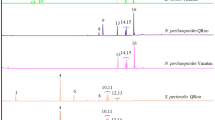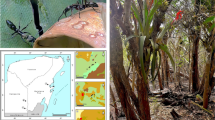Abstract
Stingless bees often associate with termites, while association with ants is uncommon due to the high costs related to the aggressiveness of ants. Few combative genera of stingless bees can associate with a larger number of hosts, including ants. Here, we describe for the first time the association between a stingless bee (Partamona testacea) and the aggressive predator bullet ant (Paraponera clavata). In the study area, the colonies of P. testacea we spotted were all associated with P. clavata or Atta sp. ants. COI mitochondrial gene sequences of bees associated with bullet ants and leafcutter ants did not show any divergence, thus revealing no evidence that the two nesting strategies represent a case of cryptic speciation and specialisation on specific hosts. Bees are not unarmed respect to the bullet ants; when ants attempted to penetrate in the colony entrance, they were dragged inside the nest and covered by a resin-like substance. Behavioural experiments focused on ants in arenas and focused on bees at their nest entrance proved that the ants are significantly less aggressive toward associated bees and that guard bees are less alarmed when associated ants are presented. We verified by Gas Chromatography and Mass Spectrometry that P. testacea maintains its species-specific cuticular signature in the association with different ant species and that ants and bees possess typical colony signatures. The differential behavioural responses expressed toward associated colony members by both species are likely based on learning these heterospecific cuticular signatures as it occurs in ant parabiotic associations.




Similar content being viewed by others
References
Aitchison J (1982) The statistical analysis of compositional data. J R Stat Soc Ser B Stat Methodol 44(2):139–177
Breed MD, Butler L, Stiller TM (1985) Kin discrimination by worker honey bees in genetically mixed groups. Proc Natl Acad Sci USA 82:3058–3061
Camargo JM, Pedro SR (2003) Meliponini neotropicais: o gênero Partamona Schwarz, 1939 (Hymenoptera, Apidae, Apinae)-bionomia e biogeografia. Rev Bras Entomol 47:311–372
Carrijo TF, Gonçalves RB, Santos RG (2012) Review of bees as guests in termite nests, with a new record of the communal bee, Gaesochira obscura (Smith, 1879) (Hymenoptera, Apidae), in nests of Anoplotermes banksi Emerson, 1925 (Isoptera, Termitidae, Apicotermitinae). Insect Soc 59:141–149. https://doi.org/10.1007/s00040-012-0218-x
Dani FR, Jones GR, Corsi S, Beard R, Pradella D, Turillazzi S (2005) Nestmate recognition cues in the honey bee: differential importance of cuticular alkanes and alkenes. Chem Senses 30:477–489
de Camargo JMF (1980) O grupo Partamona (Partamona) testacea (Klug): suas espécies, distribuição e diferenciação geográfica (Meliponinae, Apidae, Hymenoptera). Acta Amazon 10:5–175
Dejean A (2011) Prey capture behavior in an arboreal African ponerine ant. PLoS One 6(5):e19837
Dincă V, Montagud S, Talavera G et al (2015) DNA barcode reference library for Iberian butterflies enables a continental-scale preview of potential cryptic diversity. Sci Rep. https://doi.org/10.1038/srep12395
Emery VJ, Tsutsui ND (2013) Recognition in a social symbiosis: chemical phenotypes and nestmate recognition behaviors of neotropical parabiotic ants. PLoS One 8(2):e56492
Errard C, Regla JI, Hefetz A (2003) Interspecific recognition in Chilean parabiotic ant species. Insect Soc 50:268–273
Folmer O, Black M, Hoeh W, Lutz R, Vrijenhoek R (1994) DNA primers for amplification of mitochondrial cytochrome c oxidase subunit I from diverse metazoan invertebrates. Mol Mar Biol Biotechnol 3:294–299
Guerrieri FJ, d’Ettorre P (2008) The mandible opening response: quantifying aggression elicited by chemical cues in ants. J Exp Biol 211:1109–1113
Hebert PDN, Cywinska A, Ball SL, deWaard JR (2003) Biological identifications through DNA barcodes. Proc R Soc B 270:313–321. https://doi.org/10.1098/rspb.2002.2218
Katoh K, Standley DM (2013) MAFFT multiple sequence alignment software version 7: improvements in performance and usability. Mol Biol Evol 30:772–780
Kerr WE, Jungnickel H, Morgan ED (2004) Workers of the stingless bee Melipona scutellaris are more similar to males than to queens in their cuticular compounds. Apidologie 35:611–618
Lenoir A, d’Ettorre P, Errard C, Hefetz A (2001) Chemical ecology and social parasitism in ants. Annu Rev Entomol 46:573–599
Leonhardt SD, Wallace HM, Schmitt T (2011) The cuticular profiles of Australian stingless bees are shaped by resin of the eucalypt tree Corymbia torelliana. Austral Ecol 36:537–543
Menzel F, Schmitt T (2012) Tolerance requires the right smell: first evidence for interspecific selection on chemical recognition cues. Evolution 66:896–904
Menzel F, Blüthgen N, Schmitt T (2008) Tropical parabiotic ants: highly unusual cuticular substances and low interspecific discrimination. Front Zool 5:16
Michener CD (2000) The bees of the world, vol 1. JHU Press, Baltimore
Nunes TM, Turatti IC, Lopes NP, Zucchi R (2009) Chemical signals in the stingless bee, Frieseomelitta varia, indicate caste, gender, age, and reproductive status. J Chem Ecol 35:1172
Orivel J, Errard C, Dejean A (1997) Ant gardens: interspecific recognition in parabiotic ant species. Behav Ecol Sociobiol 40:87–93
Ratnasingham S, Hebert PD (2013) A DNA-based registry for all animal species: the Barcode Index Number (BIN) system. PLoS ONE 8(7):e66213
Roubik DW (1983) Nest and colony characteristics of stingless bees from Panama (Hymenoptera: Apidae). J Kans Entomol Soc 56:327–355
Roubik DW (2006) Stingless bee nesting biology. Apidologie 37:124–143
Sakagami SF, Inoue T, Yamane S, Salmah S (1989) Nests of the myrmecophilous stingless bee, Trigona moorei: how do bees initiate their nest within an arboreal ant nest? Biotropica 21:265–274
Schwarz HF (1948) Stingless bees (Meliponinae) of the western hemisphere. Bull Am Mus Nat Hist 90:1–546
Siqueira ENL, Bartelli BF, Nascimento ART, Nogueira-Ferreira FH (2012) Diversity and nesting substrates of stingless bees (Hymenoptera, Meliponina) in a forest remnant. Psyche 2012:1–9
Stucky BJ (2012) SeqTrace: a graphical tool for rapidly processing DNA sequencing chromatograms. J Biomolec Tech JBT 23:90
van Zweden JS, d’Ettorre P (2010) Nestmate recognition in social insects and the role of hydrocarbons. Insect Hydrocarb Biol Biochem Chem Ecol 11:222–243
Wille A, Michener CD (1973) The nest architecture of stingless bees with special reference to those of Costa Rica (Hymenoptera, Apidae). Rev Biol Trop 21:1–278
Wilson EO (1971) The insect societies. Harvard University Press, Cambridge Mass
Young AM, Hermann HR (1980) Notes on foraging of the giant tropical ant Paraponera clavata (Hymenoptera: Formicidae: Ponerinae). J Kans Entomol Soc 53:35–55
Acknowledgements
This work was supported by funds from Florence University and from Urku estudios Amazonicos, by Canziani funding to AL (University of Bologna) and by an International Mobility fund granted to AB by the University of Ferrara. Permits for collecting and exporting specimens were obtained by Peruvian ministry (RESOLUCIÓN DIRECTORAL EJECUTIVA N. 265-2017/GRSM/ARA/DEACRN). We thank two anonymous referees for critically reading the manuscript and suggesting substantial improvements.
Author information
Authors and Affiliations
Corresponding author
Electronic supplementary material
Below is the link to the electronic supplementary material.
Supplementary material 9 (M4 V 3448 kb)
Supplementary material 10 (M4 V 1553 kb)
Supplementary material 11 (M4 V 4745 kb)
Supplementary material 12 (M4 V 1089 kb)
Supplementary material 13 (M4 V 2849 kb)
Supplementary material 14 (M4 V 2229 kb)
Rights and permissions
About this article
Cite this article
Bordoni, A., Mocilnik, G., Forni, G. et al. Two aggressive neighbours living peacefully: the nesting association between a stingless bee and the bullet ant. Insect. Soc. 67, 103–112 (2020). https://doi.org/10.1007/s00040-019-00733-9
Received:
Revised:
Accepted:
Published:
Issue Date:
DOI: https://doi.org/10.1007/s00040-019-00733-9




